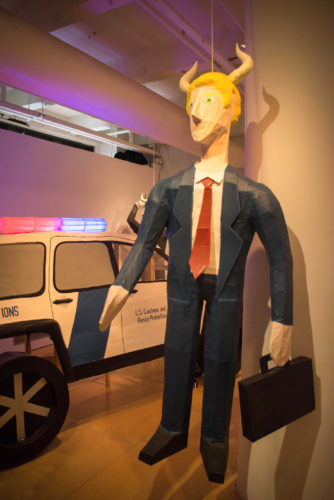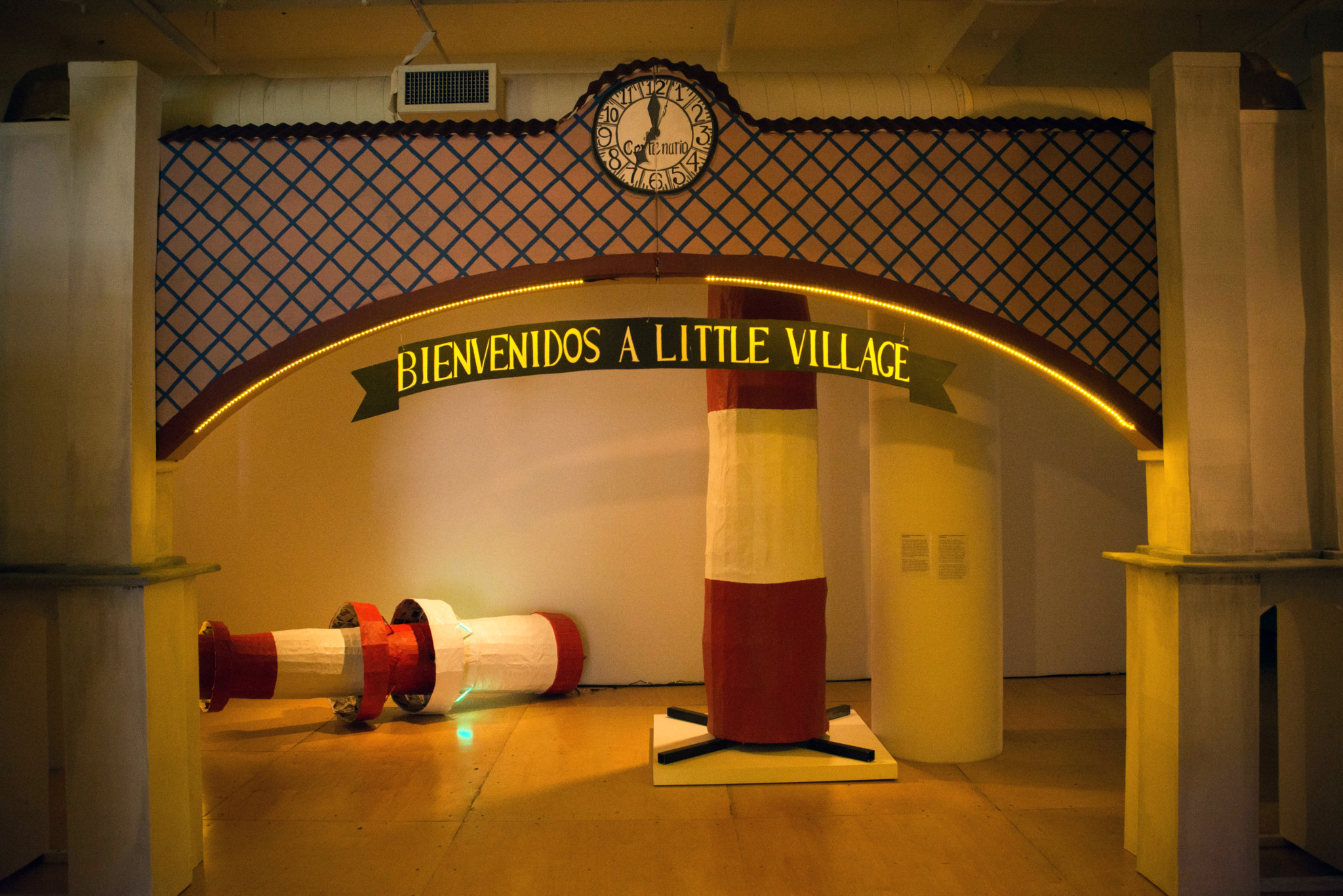As you enter the exhibition space at the University of Illinois at Chicago’s Gallery 400, you are welcomed by a familiar piece of architecture: the Little Village arch that gracefully presides over 26th Street, albeit a smaller replica. In “The Last Judgment,” currently open at Gallery 400, the arch serves as a centerpiece to the surrounding art, tying it together in the gallery’s celebration of Little Village’s history.
While the title of Adela Goldbard’s exhibit, on view until October 19th, may remind one of Michaelango’s fresco that adorns the walls of the Sistine Chapel, “The Last Judgment” is actually a direct reference to a sixteenth-century evangelical play by Franciscan priest Andres de Olmos. With this work, Olmos intended to imbue a fear into indigenous people of the horrible fate that would greet them if they didn’t accept Catholicism. Goldbard takes an intentional piece of oppression and fear-mongering and transforms it into a work of endearment and catharsis. Done in collaboration with Little Village residents, the purpose of the work is to contextualize “The Last Judgment,” and its protagonist Lucia, within contemporary Little Village.
What Goldbard creates is a multisensory experience that demands your attention as you travel between the various works. An auditory experience occupies your sense of sound with the soundtrack of Lucia’s Sunday afternoon walk and the various occurrences she happens upon. By walking between paper-mache replicas of an ICE SUV and a paleta cart, it’s easy to find yourself in Lucia’s shoes as the entire gallery evokes historical and cultural moments in the neighborhood’s story.

Yet some of the more striking pieces weren’t created by Goldbard herself. Fifth graders at Hammond Elementary School were asked to take a specifically negative experience from their lives and transform it into a more positive narrative. Among the dioramas are a building on fire, a black and red–painted canvas brandishing the word “No” and a paper-mache firearm, and a body lying beneath a bridge near an ambulance. While many of Goldbard’s pieces certainly are moving, there is something equally powerful about the raw perspective a child has of their environment.
Deeper within the space is a room equipped with headphones and decorated with images of children interacting with their neighborhood, created in collaboration with Telpochcalli Community Education Project. Teaching artist Silvia Gonzalez, a collaborator with Goldbard, invited neighborhood children to engage with their environment in an almost entirely audible way. Aided by pictures of the experiment, kids can be seen and heard interviewing each other, listening to the sounds a flower, a playground full of kids, or a stationary foot might make. There is something uniquely organic about the perspectives children have of their environment, and that’s one of the exhibit’s anchors.
This idea of perspective is something that resonates throughout the space, whether through the eyes of schoolchildren or Lucia. The stories Goldbard wants to give precedence to aren’t ones popularized in easily accessible media. Beyond the cosmetic resonance of the works, the accompanying captions offer further looks into Little Village’s history.

Relayed through these words are tales of the arch’s bronze clock, the ban on street vendors by the city’s health department in the 1990s, the ongoing ICE raids throughout the city, and the mass deportation and incarceration of undocumented immigrants in present day.
Including these historical moments within the captions encourages a fleshed out narrative surrounding a community—narratives being a central meditation of Goldbard’s work thus far. Her early studies found her delving into literature, particularly from a pre-Hispanic era. Goldbard has said that her “drive and work are born from the combination of literature, narrative and photography,” something made evident even with “The Last Judgment.” Goldbard has also continuously heralded the collaborative nature of her art. There is something to be said about a person that is not a native to the community coming into and creating a narrative around it. There was a bit of hesitation on my own part while entering the space about how well represented the community will be within the art. Goldbard alleviates these hesitations by expressing the collective efforts that produced the many pieces.
The exhibit could afford to occupy more of the negative space left by the works. But the gallery’s quaint atmosphere and the minimal pieces allow for deeper immersion, once again placing you in the shoes of Lucia. Just as a neighborhood is chaotic and serene almost simultaneously, so is the art space. It could be argued that the same experience can be had just by visiting Little Village for one’s self, but having that thematic connection with Olmos’s play gives the experience a literary edge. Goldbard made the conscious choice of recontextualizing Lucia as an immigrant from Michoacan, not far from Goldbard’s home of Mexico City.
With his play, Olmos intended to prosecute and punish any who opposed the word of God, and made Lucia an example. At the end of the play, her earrings explode into fireworks as a representation of some divine punishment. Pyrotechnics aren’t foreign to Goldbard, as nearly all of her pieces have met a fiery fate. The papier-mâché works of “The Last Judgement” will meet a similar end at a culmination event in November. Yet, instead of being a representation of the wrath of God, it is instead meant to symbolize the catharsis of a people who have seen the worst of disenfranchisement and systemic oppression.
Little Village is largely composed of Mexican immigrants, which is why it was singled out during nationwide ICE raids earlier this summer. This event isn’t forgotten in Goldbard’s exhibit and actually takes precedence over much of the art’s themes; migrants came to this country expecting better opportunity, but for many it has been an uphill battle. One of the shining qualities of communities like Little Village in this country is how it is able to retain that rich culture despite existing in a foreign place. It’s clear that with this exhibit Goldbard intended to display how, despite the many hardships, beauty continues to persevere within Mexican culture and its people.
“The Last Judgment.” Gallery 400, 400 S. Peoria St. Through October 19, with a pyrotechnic closing ceremony held as part of the Chicago Architecture Biennial at La Villita Park, 2800 S. Sacramento Ave., on Saturday, November 2, at 6:30pm. (312) 996-6114. gallery400.uic.edu
Efrain Dorado is a contributor to the Weekly and last wrote about the Virgil Abloh MCA exhibit.



